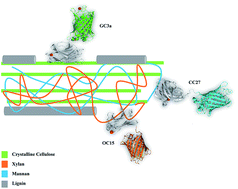当前位置:
X-MOL 学术
›
Sustain. Energy Fuels
›
论文详情
Our official English website, www.x-mol.net, welcomes your
feedback! (Note: you will need to create a separate account there.)
New insights into the enzymatic hydrolysis of lignocellulosic polymers by using fluorescent tagged carbohydrate-binding modules†
Sustainable Energy & Fuels ( IF 5.0 ) Pub Date : 2017-12-15 00:00:00 , DOI: 10.1039/c7se00427c Vinay Khatri 1, 2, 3, 4, 5 , Fatma Meddeb-Mouelhi 1, 2, 3, 4, 5 , Marc Beauregard 1, 2, 3, 4, 5
Sustainable Energy & Fuels ( IF 5.0 ) Pub Date : 2017-12-15 00:00:00 , DOI: 10.1039/c7se00427c Vinay Khatri 1, 2, 3, 4, 5 , Fatma Meddeb-Mouelhi 1, 2, 3, 4, 5 , Marc Beauregard 1, 2, 3, 4, 5
Affiliation

|
The development of a bio-based economy requires the utilization of lignocellulosic biomass in a cost-effective way. The economic viability of lignocellulosic biomass-based industries is hindered by our imperfect understanding of biomass structure and suboptimal industrial processes. To achieve such goals requires direct and rapid monitoring of lignocellulosic polymers as they are physically, chemically, and/or enzymatically treated. In this study, the recently reported fluorescent protein tagged carbohydrate binding modules method (FTCM) was used to specifically track mechanical, chemical and enzymatic-induced variations of hemicelluloses at the surface of different wood fibers. Our results showed that susceptibility to hydrolysis in kraft pulp was higher for xylan, while mannan was more vulnerable in mechanical pulps. Furthermore, FTCM rapidly and efficiently detected enzymatic inactivation and the apparent complementarity (additive and/or synergistic effect) between cellulase and other enzymes (xylanase and mannanase), significantly bolstering cellulose and hemicelluloses hydrolysis. Subsequent addition of xylanase and mannanase enzymes directly proved that xylan was acting as a physical shield which was covering mannan in bleached kraft pulp. This study suggests that mannan was closely associated with cellulose or was deeply embedded in the cell wall organization of such fibers. FTCM provided direct support for previous models on fiber structure that were based on time-consuming and complicated approaches (i.e. chromatography, spectroscopy and microscopy). FTCM allowed for the monitoring of layers of polymers as they were exposed after treatments, providing key information regarding hydrolysis optimization and the specific susceptibility of xylan and mannan to biomass treatments. We believe that by applying this simple and rapid method on site, biomass industries could substantially improve cost-effectiveness of production of biofuels and other lignocellulosic biomass-based products.
中文翻译:

使用荧光标记的碳水化合物结合模块对木质纤维素聚合物进行酶水解的新见解†
生物经济的发展需要以成本有效的方式利用木质纤维素生物质。木质纤维素生物质基产业的经济可行性受到我们对生物质结构和次优工业流程的不完全理解的阻碍。为了实现这样的目标,需要对木质纤维素聚合物进行物理,化学和/或酶处理时直接和快速的监测。在这项研究中,最近报道的荧光蛋白标记的碳水化合物结合模块方法(FTCM)用于在不同的木纤维表面上专门跟踪半纤维素的机械,化学和酶促诱导的变化。我们的结果表明,木浆对牛皮纸浆中水解的敏感性较高,而机械浆中甘露聚糖的脆弱性更高。此外,FTCM快速有效地检测到了酶的失活以及纤维素酶与其他酶(木聚糖酶和甘露聚糖酶)之间的明显互补性(加和/或协同作用),从而大大促进了纤维素和半纤维素的水解。随后添加木聚糖酶和甘露聚糖酶直接证明木聚糖起物理屏蔽作用,覆盖被漂白的牛皮纸浆中的甘露聚糖。这项研究表明甘露聚糖与纤维素密切相关或深深地嵌入了此类纤维的细胞壁组织中。FTCM为以前的基于光纤结构的模型提供了直接支持,这些模型基于耗时且复杂的方法(显着促进纤维素和半纤维素的水解。随后添加木聚糖酶和甘露聚糖酶直接证明木聚糖起物理屏蔽作用,覆盖被漂白的牛皮纸浆中的甘露聚糖。这项研究表明甘露聚糖与纤维素密切相关或深深地嵌入了此类纤维的细胞壁组织中。FTCM为以前的基于光纤结构的模型提供了直接支持,这些模型基于耗时且复杂的方法(显着促进纤维素和半纤维素的水解。随后添加木聚糖酶和甘露聚糖酶直接证明木聚糖起物理屏蔽作用,覆盖被漂白的牛皮纸浆中的甘露聚糖。这项研究表明甘露聚糖与纤维素密切相关或深深地嵌入了此类纤维的细胞壁组织中。FTCM为以前的基于光纤结构的模型提供了直接支持,这些模型基于耗时且复杂的方法(即色谱法,光谱法和显微镜法)。FTCM可以监测处理后暴露的聚合物层,提供有关水解优化以及木聚糖和甘露聚糖对生物量处理的比敏感性的关键信息。我们相信,通过在现场应用这种简单,快速的方法,生物质能行业可以大大提高生产生物燃料和其他木质纤维素生物质基产品的成本效益。
更新日期:2017-12-15
中文翻译:

使用荧光标记的碳水化合物结合模块对木质纤维素聚合物进行酶水解的新见解†
生物经济的发展需要以成本有效的方式利用木质纤维素生物质。木质纤维素生物质基产业的经济可行性受到我们对生物质结构和次优工业流程的不完全理解的阻碍。为了实现这样的目标,需要对木质纤维素聚合物进行物理,化学和/或酶处理时直接和快速的监测。在这项研究中,最近报道的荧光蛋白标记的碳水化合物结合模块方法(FTCM)用于在不同的木纤维表面上专门跟踪半纤维素的机械,化学和酶促诱导的变化。我们的结果表明,木浆对牛皮纸浆中水解的敏感性较高,而机械浆中甘露聚糖的脆弱性更高。此外,FTCM快速有效地检测到了酶的失活以及纤维素酶与其他酶(木聚糖酶和甘露聚糖酶)之间的明显互补性(加和/或协同作用),从而大大促进了纤维素和半纤维素的水解。随后添加木聚糖酶和甘露聚糖酶直接证明木聚糖起物理屏蔽作用,覆盖被漂白的牛皮纸浆中的甘露聚糖。这项研究表明甘露聚糖与纤维素密切相关或深深地嵌入了此类纤维的细胞壁组织中。FTCM为以前的基于光纤结构的模型提供了直接支持,这些模型基于耗时且复杂的方法(显着促进纤维素和半纤维素的水解。随后添加木聚糖酶和甘露聚糖酶直接证明木聚糖起物理屏蔽作用,覆盖被漂白的牛皮纸浆中的甘露聚糖。这项研究表明甘露聚糖与纤维素密切相关或深深地嵌入了此类纤维的细胞壁组织中。FTCM为以前的基于光纤结构的模型提供了直接支持,这些模型基于耗时且复杂的方法(显着促进纤维素和半纤维素的水解。随后添加木聚糖酶和甘露聚糖酶直接证明木聚糖起物理屏蔽作用,覆盖被漂白的牛皮纸浆中的甘露聚糖。这项研究表明甘露聚糖与纤维素密切相关或深深地嵌入了此类纤维的细胞壁组织中。FTCM为以前的基于光纤结构的模型提供了直接支持,这些模型基于耗时且复杂的方法(即色谱法,光谱法和显微镜法)。FTCM可以监测处理后暴露的聚合物层,提供有关水解优化以及木聚糖和甘露聚糖对生物量处理的比敏感性的关键信息。我们相信,通过在现场应用这种简单,快速的方法,生物质能行业可以大大提高生产生物燃料和其他木质纤维素生物质基产品的成本效益。











































 京公网安备 11010802027423号
京公网安备 11010802027423号